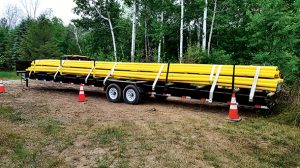Understanding the propane versus natural gas conversation

Yellow pipe means natural gas is infringing on your market. Photo courtesy of Tom Jaenicke.
When a load of yellow pipe and a trencher show up in your best marketing neighborhood, you have become the victim of the energy switching tactics of the natural gas utility.
It is successful at switching groups of consumers from propane to natural gas by feeding them outdated, inaccurate and sometimes false information about propane versus natural gas. Claims of energy savings will be based on the highest pre-fracking propane prices and the masking of natural gas delivery charges and fees versus gas cost.
Then come the bait-and-switch hook-up offers, the downplaying of appliance conversion or replacement costs, no mention of interior gas line upsizing replacement, and, of course, the offer of (high interest) financing to cover all of these costs. The natural gas industry is not telling lies. It is just citing selective information that feeds into the old perceptions of residential propane.
Although they can vary widely by state, propane prices are as low as they’ve been in many years, due to increased production levels and the forecast of generous supply for the foreseeable future. In most cases, propane is much less expensive than nonrenewable electricity and an even better value when compared to the high cost of electricity produced by renewable resources.
Yes, propane still costs more per Btu than natural gas. However, consider the parallels between the fuel economy achievements in the automotive industry and the increased efficiency of most residential gas appliances and heating equipment.
Years ago, when car companies were building poor-mileage vehicles, car shoppers were flocking to models with better gas mileage. Now that overall mileage standards have improved dramatically, the price of gas doesn’t have the same impact on car-buying decisions as it used to. We pay more for gas, but use less of it. Today, car buyers are shopping for SUVs over all other models, due to the increased mileage performance that more than offsets the increase in gas prices.
That same dramatic efficiency increase has happened in today’s residential gas heating equipment and appliances. An old propane forced-air furnace may have limped along at 70 percent or less annual fuel utilization efficiency (AFUE), but a modern affordable propane furnace is at 95-98 percent AFUE.
Couple that with today’s lower-than-perceived propane prices, and it offers consumers a positive financial impact. Consumers pay less for propane than perceived and use less of it. This makes the argument for switching to natural gas much less powerful, especially considering all other costs of switching. Of course, none of that is explained by the natural gas utility when it is in energy-switching mode.
The main difference between the automotive efficiency advancements and those of the gas heating equipment and appliances is that the average consumer gets a new car every 2-5 years, while a furnace can be used for 15-20 years or more. The slow turnover of gas appliances continues to fuel the perception of “expensive,” old-fashioned propane that the natural gas industry feeds on.
The National Propane Gas Association does a good job of helping state and regional propane associations fight the lobbying battle against unfair laws and regulations, but no other industry action is being taken to update the perception of propane. If you want a dose of propane perception, Google “switch from propane to natural gas” and see what comes up. The industry is missing in action here, and I don’t understand why. The Propane Education & Research Council admirably promotes propane appliances, but turns its back on the rest of the battle with natural gas and the emerging plans for the electrification of America.
Solutions have been proposed to make propane consumers think twice about energy switching, but the industry isn’t ready to tackle those old perceptions yet. In the meantime, loads of yellow pipe may be heading to your marketing area.
Tom Jaenicke is vice president of propane marketing services for Warm Thoughts Communications.
















